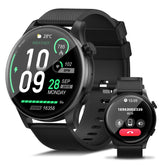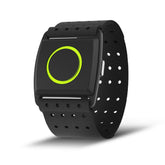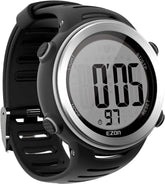Stress - Busting Sports: Use Your Heartbeat Monitor to Find Your Zen
In a world filled with deadlines and demands, sports become more than exercise—they’re a sanctuary. Paired with a heartbeat monitor, they transform into a science of stress relief, allowing you to tune into your body’s signals and move toward calm. This guide reveals how sports and real-time heart rate data can lower stress, boost mood, and help you find balance—no mat or gym membership required.
1. The Stress-Exercise Connection: Why Movement Matters
A. The Science of Stress Relief
- Cortisol Reduction: 30 minutes of moderate exercise lowers cortisol (the stress hormone) by 15–20%, according to a 2024 study in Journal of Sports Medicine.
- Heart Rate Variability (HRV): Higher HRV signals better stress resilience—your heartbeat monitor tracks this metric, showing how exercise improves your body’s ability to handle pressure.
B. How Heart Rate Data Guides Relief
- Stress Score (1–100): Many monitors calculate this in real time, using HRV and heart rate to alert you when tension rises (e.g., score >70 = time to slow down).
- Recovery Insights: Post-workout, a fast heart rate drop (20 BPM/min) indicates effective stress release; slow recovery means adjust intensity.
2. Best Stress-Relieving Sports for Every Mood
A. Calm the Mind: Low-Intensity, Mindful Movement
Yoga & Tai Chi (Zone 1–2, 50–70% Max HR)
- Why It Works: Slow, controlled poses activate the parasympathetic nervous system (rest-and-digest mode), reducing muscle tension.
- Heart Rate Tip: Pair poses with 4-7-8 breathing (inhale 4s, hold 7s, exhale 8s)—use your monitor to ensure heart rate stays below 70% max HR.
Nature Walks & Hikes (Zone 1, 50–60% Max HR)
- Benefits: 20 minutes in green spaces cuts cortisol by 12% (University of Michigan research); your monitor’s GPS tracks steps and elevation for gentle accountability.
B. Release Tension: Moderate Aerobic Activity
Steady-State Running/Cycling (Zone 2, 60–70% Max HR)
- Rhythmic Relief: Repetitive movements like jogging or cycling create a “flow state,” distracting from stressors while boosting endorphins.
- Data Focus: Aim for a “conversational pace” (speak in full sentences), confirmed by your monitor’s heart rate zone alerts.
Swimming (Zone 2–3, 65–80% Max HR)
- Low-Impact Stress Buster: The resistance of water adds mindfulness to movement; track stroke rate to ensure steady, meditative effort.
C. Boost Confidence: Strength Training & Team Sports
Weightlifting (Zone 3, 70–80% Max HR)
- Empowerment Through Movement: Lifting weights releases testosterone and endorphins, improving self-efficacy.
- Heart Rate Guide: Rest 60–90 seconds between sets to keep heart rate in Zone 3, avoiding overexertion (and extra stress).
Team Sports (Zone 3–4, 75–90% Max HR)
- Social Stress Relief: Playing soccer or basketball combines physical exertion with camaraderie, reducing stress via social connection.
- Monitor Use: Track average heart rate during games to ensure you’re in a sustainable zone (avoid redlining, which can spike stress).
3. Decode Your Body’s Stress Signals with Data
A. Real-Time Stress Alerts
-
High Stress (Score 70+):
- Action: Pause and switch to Zone 1 activity (e.g., 5-minute guided breathing on your monitor).
-
Optimal Relief (Score 40–60):
- Action: Continue current activity (e.g., yoga, easy run) to maintain calm.
B. Post-Workout Recovery Analysis
- HRV Trend: A upward trend post-exercise means your body is adapting well to stress relief.
- Resting Heart Rate (RHR): A 3–5 BPM drop in weekly RHR signals improved cardiovascular health and lower baseline stress.
C. Sleep for Stress Resilience
- Deep Sleep Tracking: Ensure 15–20% of sleep is deep sleep (critical for cortisol regulation)—use your monitor’s sleep staging to adjust bedtime routines (e.g., no screens 1 hour pre-bed).
4. Create Your Stress-Busting Routine
A. Weekly Plan Based on Stress Levels
High-Stress Days (Stress Score >70)
- Activity: 30-minute yoga + 10-minute guided breathing (monitor-led).
- Heart Rate Focus: Keep below 65% max HR; use vibration alerts to stay in Zone 1.
Medium-Stress Days (Score 50–70)
- Activity: 45-minute steady bike ride or hike, practicing rhythmic breathing (inhale 2 steps, exhale 2 steps).
- Data Goal: Maintain Zone 2 (60–70% HR) for consistent stress reduction.
Low-Stress Days (Score <50)
- Activity: 20-minute HIIT or team sport to boost mood and resilience.
- Heart Rate Limit: Cap at Zone 4 (90% HR) to avoid turning fun into stress.
B. 4-Week Progressive Plan
| Week | Focus | Sample Workout | Heart Rate Metric to Track |
|---|---|---|---|
| 1 | Foundation | 3x30-minute walks + 2x20-minute yoga | Stress score post-activity |
| 2 | Rhythmic Movement | 2x45-minute cycling + 1xteam sport | HRV trend after workouts |
| 3 | Mind-Body Connection | 3x40-minute yoga + 1xnature hike | Resting heart rate weekly |
| 4 | Peak Relief | Mix of all activities, monitor-guided | Weekly average stress score |
5. Gear for Stress-Free Movement
A. Heartbeat Monitor Features
| Feature | Stress Relief Benefit | EZON Recommendation |
|---|---|---|
| Stress Scoring | Real-time alerts to adjust activity intensity | EZON Heart Rate Series |
| Guided Breathing | In-watch exercises to lower heart rate quickly | EZON Pro Wellness Watch |
| Sleep Recovery | Deep sleep analysis for cortisol regulation | EZON Sleep & Stress Monitor |
B. Activity-Specific Gear
- Yoga/Meditation: Lightweight, breathable clothing; use a wrist-based monitor for unobtrusive tracking.
- Outdoor Activities: Rugged GPS watch (e.g., EZON GPS Series) for nature hikes, with 10ATM water resistance for all weather.
6. Common Mistakes to Avoid
-
Overtraining to “Escape” Stress:
- Solution: Use your monitor’s stress score—if it rises during exercise, switch to gentler activity.
-
Ignoring Post-Workout Recovery:
- Solution: Schedule 10 minutes of foam rolling post-workout; track HRV to ensure stress doesn’t carry over.
-
One-Size-Fits-All Routines:
- Solution: Let your monitor guide you—high HRV means try new activities, low HRV calls for familiar, calming movements.
7. FAQs: Your Stress-Relief Questions Answered
Q: Can high-intensity workouts increase stress?
- Yes, if done when already stressed. Use your monitor’s stress score—only do HIIT when score <60 for optimal relief.
Q: How soon do I see stress relief benefits?
- Most feel calmer after 10–15 minutes of movement; physiological changes (lower cortisol) appear after 2–4 weeks of consistent training.
Q: Do I need a chest-strap monitor for accuracy?
- Wrist-based monitors (like EZON’s) are accurate for stress relief purposes; chest straps are optional for intense workouts.
Move with Purpose, Breathe with Ease
With a heartbeat monitor as your stress coach, every workout becomes a step toward balance. Let data guide you to the right intensity, remind you to breathe, and celebrate every drop in stress score. Whether you’re flowing through yoga, hiking a trail, or lifting weights, let movement be the therapy that syncs your heart and mind.
Gear up, tune in, and let your heartbeat lead the way to a calmer, more resilient you. Stress may be part of life, but with the right tools and movements, you’ll turn pressure into purpose—one heartbeat at a time.
EZON Watch: Professional sports technology brand
https://ezonwatch.com
https://ezonwatch.com









